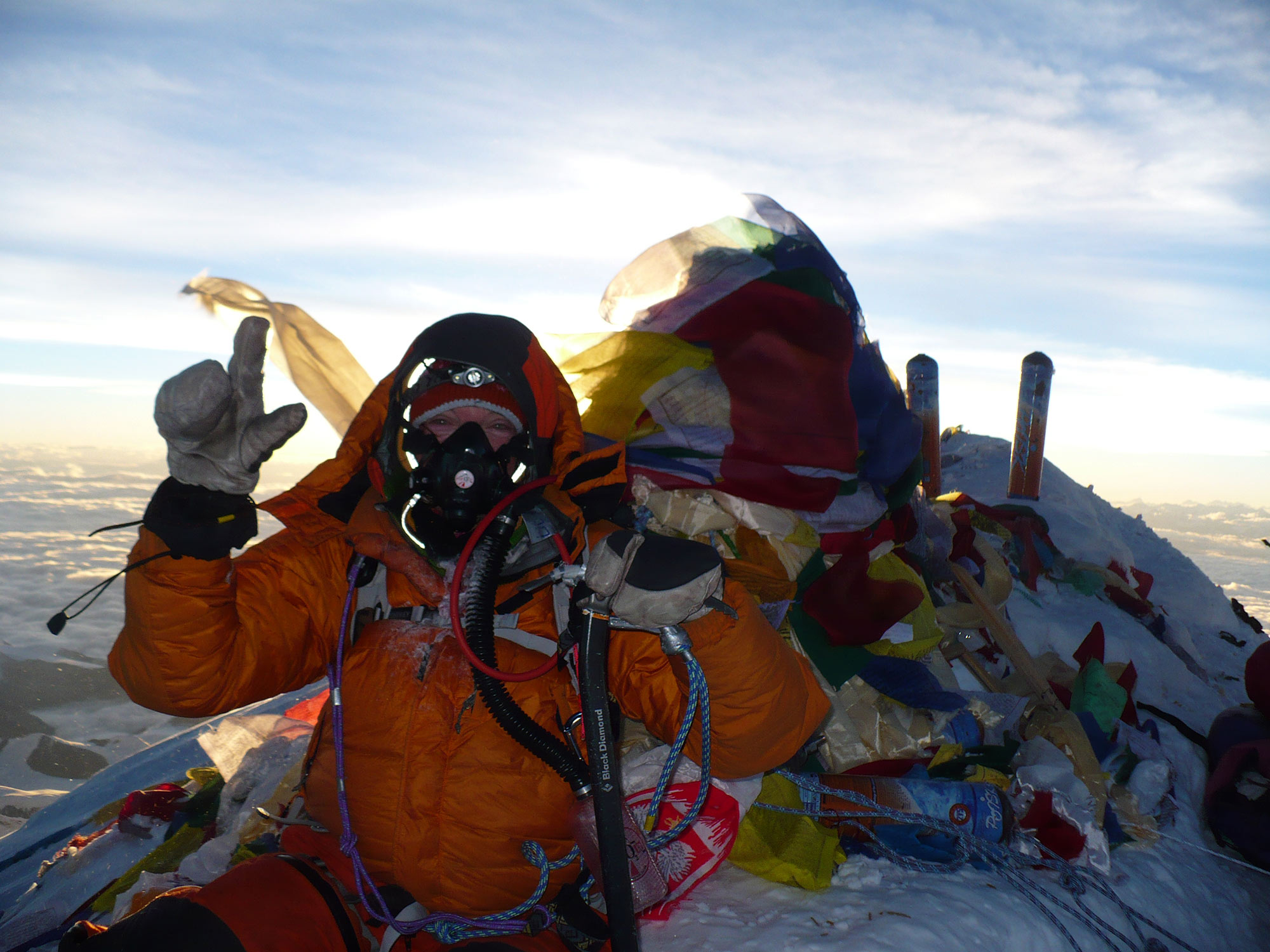- Experiences >
- Destinations >
- Gear >
- About Us >

Lydia Bradey’s 6th Everest summit
Last Wednesday, 22nd May, I climbed Mt Everest for the 6th time, my first from the North /Tibet. My climbing partners were Mingma, Pasang and Roxanne Vogel: @roxymtngirl. We were alone on the mountain aside from the Chinese Tibet Mountaineering Association (CTMA) rope-fixers, who reached the summit half an hour before us. They all high-fived us and all hugged us too on the way down, such a special, unique experience.
Roxy made a VERY rapid ascent, summiting within 11 days of arriving in the country. She had been training intensely for a year, and she is a Nutritionist for Gu Products, tailoring nutritional supplements for everything from recovery to mental acuity. Her second conversational line to me was “don’t worry about me, I’m a nerd!” ( A very cute nerd I have to say!)
However, Roxy had never climbed above 7000m. Even our Camp 2 at 7700m, from which we climbed, eliminating C3 (8300m) was a “PB” – a Personal Best, by a long way!
The key for Roxanne was to be utterly extremely fit, used to carrying heavy loads uphill, a very good natural acclimatizer, and pre-acclimatized to circa,7000m. In Roxannes case, she used Hypoxico low- oxygen tents both to sleep in and to work inside of at times.
None of this prep was easy for Roxy, and she forgave any social life, ate super carefully, did training scheduled by some well-known climbers who have developed a program called Uphill Athlete, and squeezed in (very) rapid ascents of South American volcanoes over Christmas…that was her life for a year.
Roxanne also paid a lot of money to have a private guide, and requested a female guide ( go the #sistahood !) Alpenglow Expeditions already ran a Rapid Ascent program and were super keen to support a nick-named: Lightning Ascent. Their doctor, Moni Piris, a Spanish/UK doctor, remains one of the most experienced altitude doctors around ( and is one of my closest friends); oversaw the ascent via WhatsApp from Spain.
The result is that Roxanne has accomplished something no Westerner – and we are certain no one else ever has previously achieved; an ascent of Everest within 10 days of arriving in China, AND she had a positively life-changing adventure. I am so lucky to share! She did an amazing job!
People often “dis” the Guiding & Climbing Of Everest, describing it as a Circus. The recent re-posted image of the summit from the 22nd of May this year, on the Nepal Side confirms many’s doubts. However, in the 6 times I’ve reached the summit, I myself or with my small team of clients (1-2) and Sherpas (2-4), we have been alone on the summit of the highest mountain in the world exactly 50% of the summits. Last year (2018), from Nepal on an Adventure Consultants ( NZ) Expedition, members Brad & Mike, our four Sherpas lead by Sirdar Rinji, (all four carrying HEAPS of spare oxygen) and I – our little team, were the first to reach the summit by 40 minutes , and we watched the dawn rise on the world. Those 40 minutes surely remain some of my most memorable summit days on any mountain!
This year again – the whole journey with Roxy has bonded the two of us in an adventure of a lifetime. Again we were the ONLY climbers on the whole North side of the mountain that day – apart from the rope fixers as I said, in a season where there were only three summit day weather windows on the mountain!
On Everest, I am always guiding for a high-end Guiding company, usually for Adventure Consultants (NZ) and this year for Alpenglow Expeditions (USA).
A high-end Guiding company (this is simply an expression) costs a lot of money, provides very good food, usually has a Doctor on site, provides individual tents to about 6400m, and employs a lot of Sherpas. On summit day these Sherpas carry a LOT of oxygen and this oxygen is the key.
On a high-end expedition, you will climb on summit day and perhaps the day before up to high camp, on 4L of oxygen/ min ( it’s mixed with ambient air). Each 4kg tank will last you 4-5hrs depending upon how full they are when you screw the regulator on.
It would be unusual for a cheap operation to provide more than 2L /min for summit day, and some would have no more than 2 bottles available for the client- because the client HASN’T PAID for lots of oxygen.
This is the clients choice to go cheap. But on Everest, there’s no escaping that going cheap is risking your life.
In the case with Everest expeditions, you get what you pay for; a cheaper expedition will have a high ratio of client (or “member” as they are called) to guide, or no guide at all. Limited or no medical support, overworked and fatigued Sherpas and low ratio of Sherpa to member; and not very much oxygen.
If you are climbing too slowly on summit day, and the maths with O2 flow rates and number of oxygen bottles doesn’t stack up… you will probably be told by your Sherpa or guide that you should turn around. Sometimes people actually get “Summit Fever“ and they refuse to turn around. Possibly some people don’t even have a Sherpa with them and don’t know to check their O2 bottles.
Others wouldn’t know how to pass people safely on a fixed line, going up or down, nor how to bail, and descend. These days its common for people NOT to carry ice axes on the climb, reducing their independence if they need to pass up or down, or if a fixed line breaks, limiting their escape from chaos.
Thus sometimes, but not always, tragic avoidable deaths occur in crowded conditions when the climber has paid for a cheap trip.
There’s so much to say or discuss… as in any tourism in the world, there is a population boom. To cut corners some cheap operators are even leaving their rubbish in the tents at 8000m, sometimes cutting their logos out of the sides of the tents and deserting the metal and plastic on the hill; increasing detritus on the mountain, and very severely reducing camping space.
Alternatively, the best operators are striving to improve their service, skills and safety, reducing their footprint and increasing their success rates.
The bottom line is still the mountain. If you get lots of good weather in a season there will be no traffic jams. If there are only 3 days to Summit in a season then clever strategising and lots of resources (ie oxygen and people to carry it) is essential. In addition, If your operator pays five figures for (Swiss) weather forecasting, you won’t be caught out by a storm.
So, if it’s like this, why do we go to this mountain?
I climbed Everest once simply as a young ambitious mountaineer in 1988, and I was very alone, no oxygen (first female ascent no O2), no fixed rope above South Col 8000m (which protects you from losing your way) no climbing buddy, no weather forecasting.
Since 2008 I have returned 5 times as a guide, and have learned so much along the way! If you can manage your health and your clients’ and create a summit day that really works, it is a hugely satisfying achievement. No one can take a mountain summit you’ve experienced away from you, it is always deep inside.
When you climb Everest you only partly climb it for the view looking out. The real view is the FEELING of being on the highest mountain in the world. It’s really really high! It’s really really amazing.
It’s the feeling of being human and alive and yet walking (scrambling, climbing…) up a monolith that you have grown up knowing about in theory. You say to yourself – I said to myself on Wednesday the 22nd, “I’m on the highest mountain in the world! This is what being high-up is like…”
Up a mountain ingrained in our psyche as HIGH; up to a point so recognised, that should you buy a cheap plastic globe for a child, it is probably defined by a dot and a name, and you are on that dot; up a mountain that is described as a concept in motivation psychology “… everyone has an Everest…”
Getting it right, getting the view, sharing the experience, coming back with all fingers and toes, and those of your Sherpa guides of course is part of the excellence of the journey. Having the skills and opportunity to lead others in this journey is a joy and a privilege. As a female mountain guide, seeing younger female guides come through (Carla Perez (Alpenglow Expeditions), Pachi (Maria) Ibarra (Kobler & Partner Expeditions) for example is super inspiring (#sistahood).
Standing with your small team alone on the summit of the world’s highest mountain is still possible to achieve, and that is an experience I shall always carry in my heart.
@lydiabradey | #everestgal | lydiabradey.com
